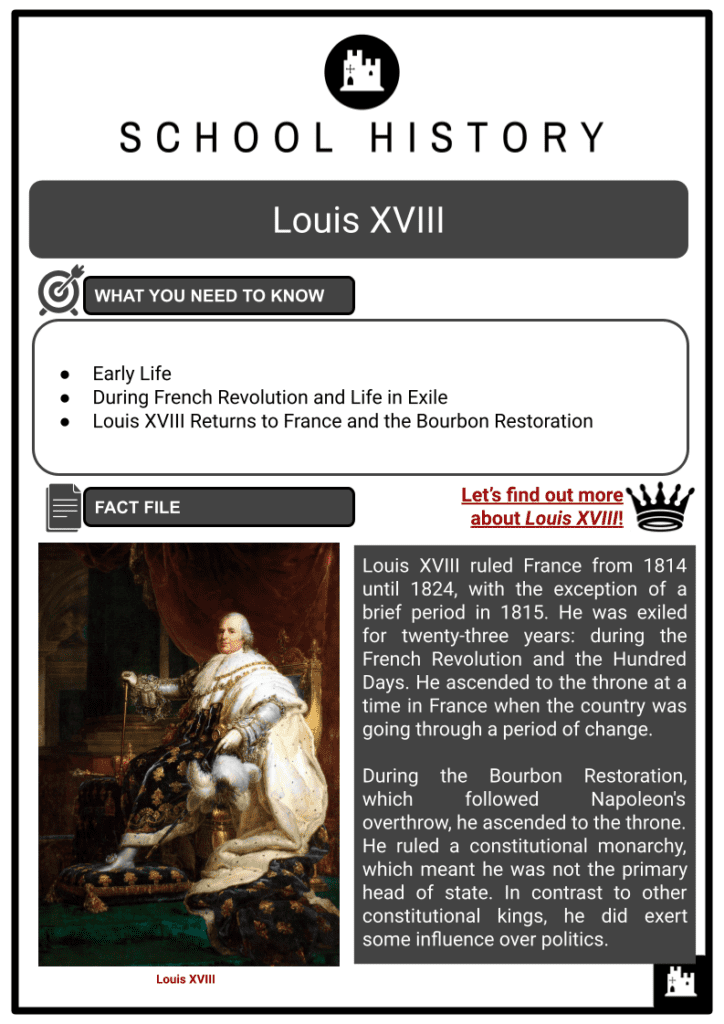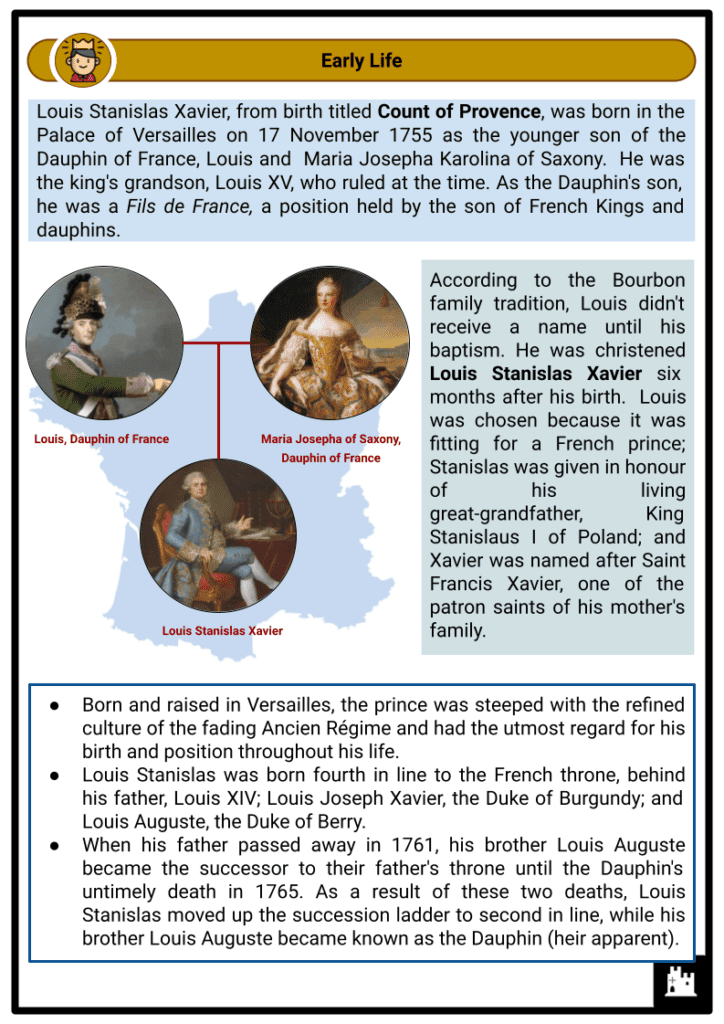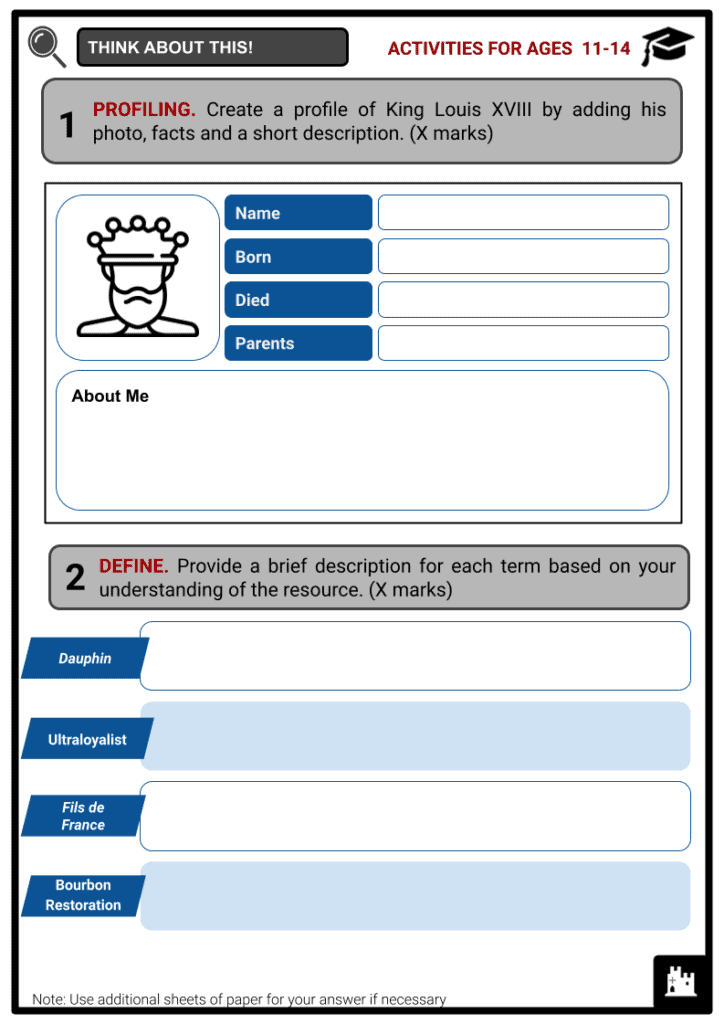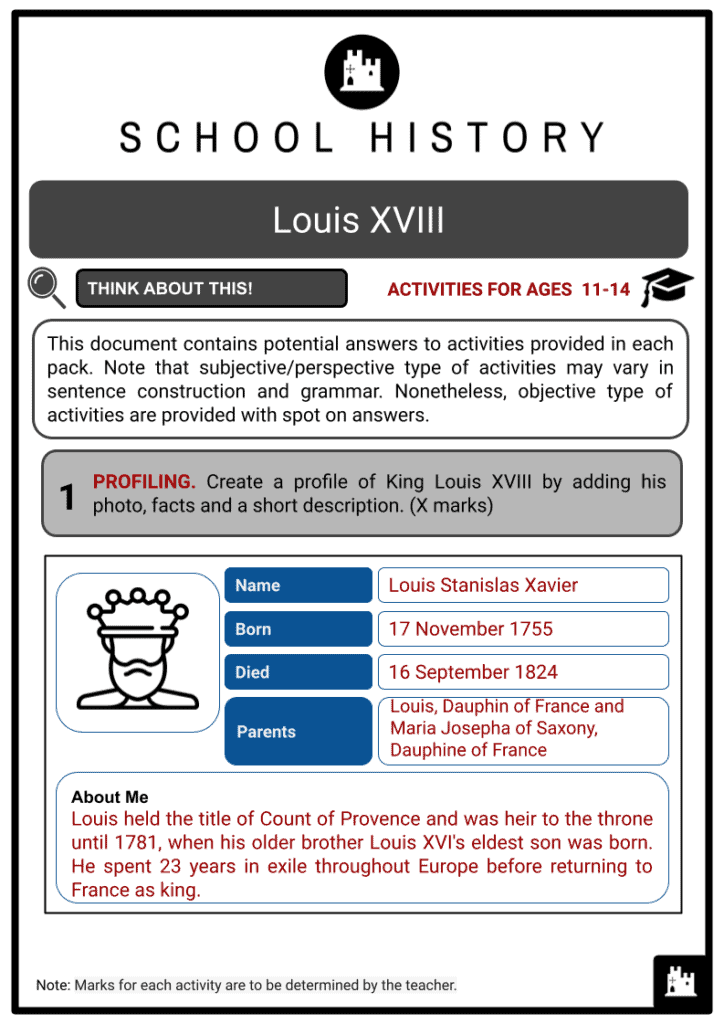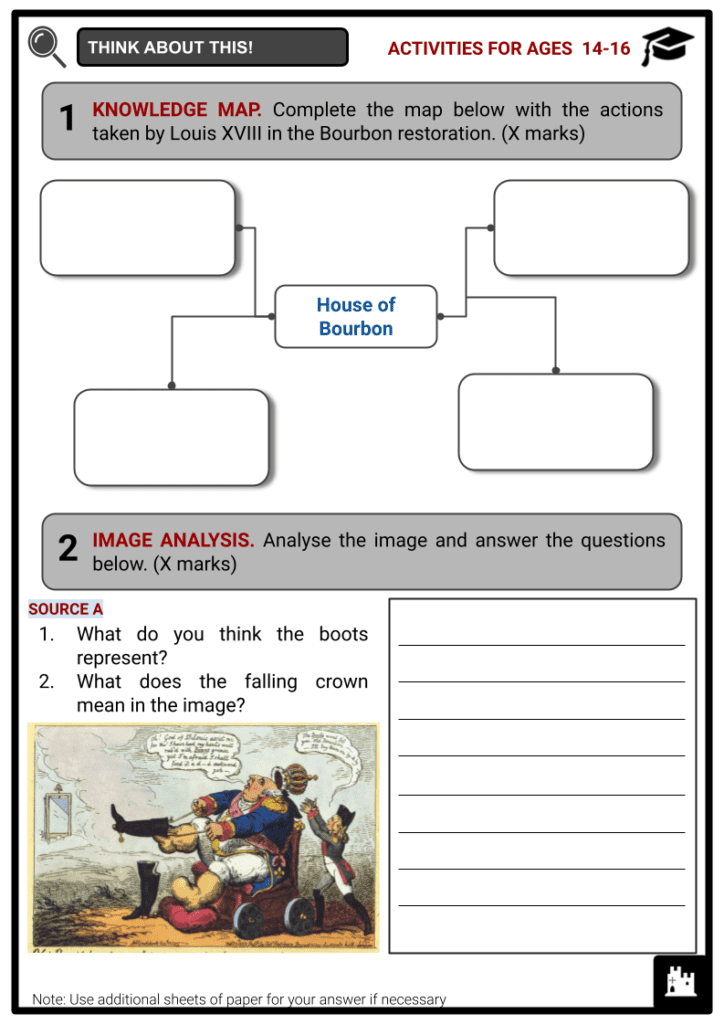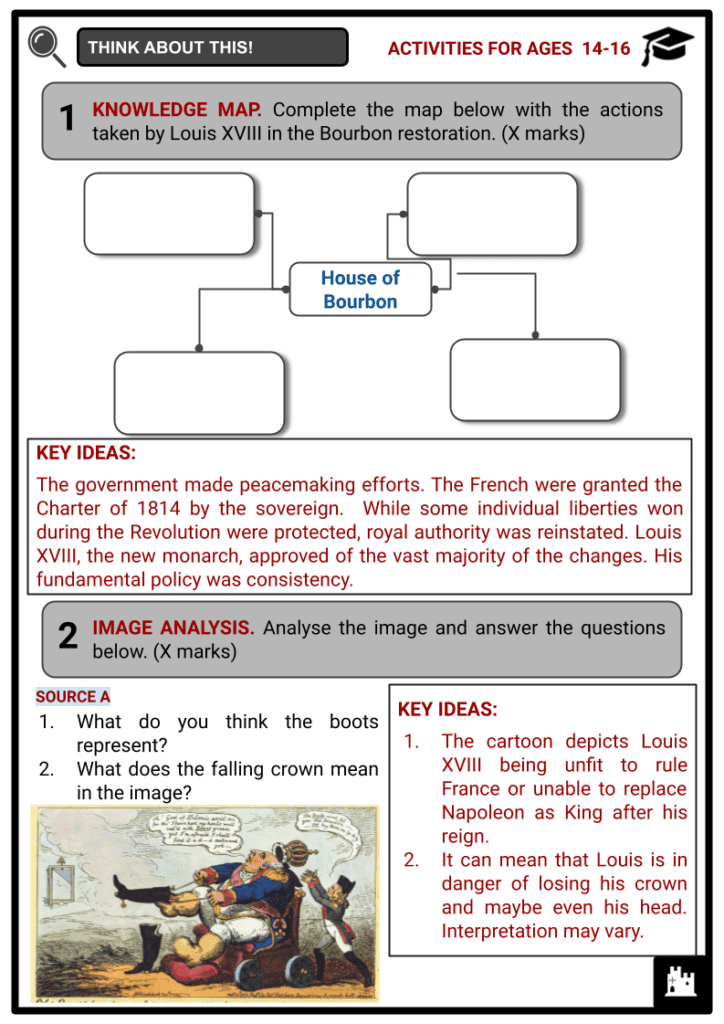Louis XVIII Worksheets
Do you want to save dozens of hours in time? Get your evenings and weekends back? Be able to teach about Louis XVIII to your students?
Our worksheet bundle includes a fact file and printable worksheets and student activities. Perfect for both the classroom and homeschooling!
Summary
- Early Life
- During French Revolution and Life in Exile
- Louis XVIII Returns to France and the Bourbon Restoration
Key Facts And Information
Let’s find out more about Louis XVIII!
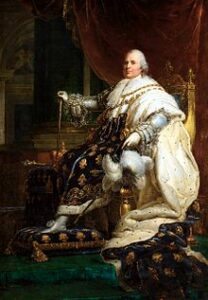
Louis XVIII ruled France from 1814 until 1824, with the exception of a brief period in 1815. He was exiled for twenty-three years: during the French Revolution and the Hundred Days. He ascended to the throne at a time in France when the country was going through a period of change. During the Bourbon Restoration, which followed Napoleon's overthrow, he ascended to the throne. He ruled a constitutional monarchy, which meant he was not the primary head of state. In contrast to other constitutional kings, he did exert some influence over politics.
Early Life
- Louis Stanislas Xavier, from birth titled Count of Provence, was born in the Palace of Versailles on 17 November 1755 as the younger son of the Dauphin of France, Louis and Maria Josepha Karolina of Saxony. He was the king's grandson, Louis XV, who ruled at the time. As the Dauphin's son, he was a Fils de France, a position held by the son of French Kings and Dauphins.
- According to the Bourbon family tradition, Louis didn't receive a name until his baptism. He was christened Louis Stanislas Xavier six months after his birth. Louis was chosen because it was fitting for a French prince; Stanislas was given in honour of his living great-grandfather, King Stanislaus I of Poland; and Xavier was named after Saint Francis Xavier, one of the patron saints of his mother's family.
- Born and raised in Versailles, the prince was steeped in the refined culture of the fading Ancien Régime and had the utmost regard for his birth and position throughout his life.
- Louis Stanislas was born fourth in line to the French throne, behind his father, Louis XIV; Louis Joseph Xavier, the Duke of Burgundy; and Louis Auguste, the Duke of Berry.
- When his father passed away in 1761, his brother Louis Auguste became the successor to their father's throne until the Dauphin's untimely death in 1765. As a result of these two deaths, Louis Stanislas moved up the succession ladder to second in line, while his brother Louis Auguste became known as the Dauphin (heir apparent).
- Louis Stanislas was a bright young boy who excelled in the classics. Although Louis Auguste was the heir and Louis Stanislas was not, the quality and continuity of his education were not compromised.
- Most of Louis Stanislas' professors were priests, including the Bishop of Limoges, Jean-Gilles du Cotlosquet, the Abbé of Limoges, Jean-Antoine Nollet, and the Jesuit Guillaume-François Berthier.
- In April 1771, at the age of fifteen, Louis Stanislas' formal education ended, and he set up his own independent household. His grandfather, King Louis XV, bestowed upon him the titles of Duke of Anjou, Count of Perche, Count of Maine, and Count of Senoches all in the same month that Louis established his household. He was commonly addressed as "Count of Provence" during this time.
- On 14 May 1771, Louis married Princess Maria Giuseppina of Savoy at the Palace of Versailles. She was the daughter of Victor Amadeus, the Duke of Savoy, and his wife, Maria Antonia Ferdinanda of Spain.
- Due to Princess Maria Giuseppina's two miscarriages, the couple never had any children together.
During his brother’s rule
- King Louis XV fell ill in April 1774, after getting smallpox, and died on 10 May 1774, at the age of 64. Louis Auguste, the older brother of Louis Stanislas, succeeded their grandfather as King Louis XVI.
- As the king's eldest sibling, Louis Stanislas was given the title Monsieur. Louis Stanislas desired political power. He attempted to join the King's council in 1774, but was unsuccessful.
- In December 1774, Louis XVI handed Louis Stanislas funds from the Duchy of Alencon. The duchy was bestowed to Louis Stanislas to boost his reputation. However, the appanage only yielded 300,000 livres per year, which was far less than its height in the fourteenth century.
- On 5 May 1778, Queen Marie Antoinette's physician, Dr. Lassonne, confirmed her pregnancy. She gave birth to a daughter on 19 December 1778, who was named Marie-Thérèse Charlotte de France and granted the title Madame Royale.
- The fact that the newborn was a girl was a relief to the Count of Provence, who retained his status as Louis XVI's heir because Salic Law prohibited women from ascending to the French throne.
- Unfortunately, Louis Stanislas' time as successor was short-lived. Marie Antoinette gave birth to Louis Joseph, the future Dauphin, on 22 October 1781.
- The birth of Marie Antoinette's second son, Louis Charles, in March 1785 pushed Louis Stanislas even lower in the line of succession.
- Anne Nompar de Caumont, Countess of Balbi, began her service as the new lady-in-waiting for Marie Joséphine in 1780. Soon after, Louis Stanislas fell in love with his wife's servant and set her up as his mistress, causing the couple's already limited fondness for one another to diminish completely.
- Louis Stanislas didn't have much to do at this time because he had stopped being involved in politics in 1774. He was living a quiet, inactive life. He read for several hours every morning at Balbi's pavilion in his large library of more than 11,000 books. He also racked up massive debts totalling 10 million livres at the start of the 1780s, which his brother Louis XVI paid.
- In February 1787, General of Finance Charles Alexandre de Calonne held an Assembly of Notables to call for financial reform. Since Louis Stanislas strongly disapproved of Calonne's extreme reform proposals, this gave him the chance he had been waiting for to make his mark on politics. The notables unanimously rejected Calonne's proposal, and as a result, Louis XVI dismissed him.
Beginning of French Revolution and Life in Exile
- In May of 1789, the Estates-General (French general assembly) met to ratify financial reforms. Louis Stanislas advocated a hard stance against its tax reform objectives.
- Louis Stanislas pushed the King to take decisive action against the declaration, while the King's popular finance minister, Jacques Necker, sought a compromise with the new assembly.
- On 9 July 1789, the assembly announced itself to be the National Constituent Assembly, which would create a constitution for France. King Louis XVI sacked Necker on 11 July, which led to severe rioting in Paris.
- The sabre charge of the Royal German Cavalry Regiment of Charles-Eugène de Lorraine, Prince de Lambesc, against a mass gathered in the Tuileries Gardens on 12 July provoked the ensuing Storming of the Bastille two days later.
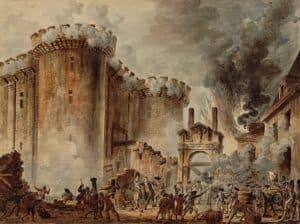
Storming of The Bastille - On 16 July, King Louis' brother, Charles, Comte d'Artois, along with his wife and children, and a large number of courtiers, departed France. Louis Stanislas opted to stay in his French court. When King Louis XIV and his family planned to flee to Metz, Louis Stanislas convinced him to stay in Versailles instead.
- Following the Women's March on Versailles on 5 October 1789, the Royal Family was compelled to depart the palace. A trip to Paris was arranged for them. There, the Tuileries Palace housed the Royal Family while the Luxembourg Palace hosted the Count of Provence and his wife.
During Exile
- The National Assembly passed a law in March 1791 defining the regency of Louis Charles in the event of his father's untimely death. The closest male relative in France to Louis Charles was appointed regent under this rule which at that time was the Count of Provence.
- In June of 1791, Louis Stanislas escaped France for the Austrian Netherlands. King Louis XVI and his family unsuccessfully attempted to depart the country.
- Upon reaching the Low Countries, the Count of Provence declared himself to be the de facto regent of France. A document he and Louis XVI co-wrote just before the latter's unsuccessful attempt to flee to Varennes was used to his advantage.
- The Condé princes and the Count of Artois openly declared their intention to invade France. Louis Stanislas dispatched envoys to various European courts requesting financial assistance, soldiers, and ammunition.
- In August 1791, the Declaration of Pillnitz was issued, urging Europe to interfere in France if King Louis XVI or his family were threatened. It declared the Holy Roman Empire and Prussia's combined support for King Louis XVI of France against the French Revolution. France reacted negatively to Provence's endorsement of the declaration.
- In January 1792, the Legislative Assembly labelled all of the émigrés (French aristocrats who fled France during the French Revolution) as traitors. Their possessions and titles were seized. The National Convention abolished the French monarchy on 21 September 1792.
- On 21 January 1793, King Louis XVI was publicly executed at Revolution Square. In his death, his little son Louis Charles became King at the age of 8. The exiled prince was anointed "Louis XVII of France." As his nephew was too young to be head of the House of Bourbon, the Count of Provence declared himself regent.
Succeeding the throne
- The little King passed away in a prison cell on 8 June 1795. His only living sibling was his sister Marie-Thérèse, but due to France's traditional commitment to Salic law, she was not considered a candidate for the throne. As a result, on 16 June, the princess-in-exile proclaimed the Count of Provence to be Louis XVIII.
- Louis XVIII drafted a declaration in response to the death of Louis XVII. The manifesto, also known as the "Declaration of Verona," was Louis XVIII's attempt to present his politics to the French people. The Declaration of Verona drew France back into the monarchy's embrace.
- He was able to maintain an appearance in court, which secured the respect he required to keep his rank. In spite of revolutionary France and European monarchies, Louis persisted in trying to assert his authority as king of France.
- Napoleon Bonaparte's invasion of the Republic of Venice in 1796 compelled Louis XVIII to escape Verona and moved to Blankenburg in the Duchy of Brunswick.
- In 1800, Louis XVIII wrote to Napoleon Bonaparte, then First Consul of France, pleading with him to return the Bourbons to the throne. However, the future emperor was not convinced and instead focused on strengthening his own position as head of state in France.
- Napoleon attempted to coerce Louis XVIII to surrender his claim to the French monarchy in 1803, but Louis refused. The following year, in May of 1804, Napoleon proclaimed himself Emperor of France.
- From 1795 to 1814, Louis travelled all throughout Europe, staying in Prussia, England, and Russia while advocating for the royalist cause despite its seemingly hopeless situation following Napoleon's 1804 proclamation as emperor.
Louis XVIII Returns to France and the Bourbon Restoration
- In the wake of Napoleon's losses in 1813, Louis released a manifesto in which he pledged to acknowledge some of the Revolution's results in a restored Bourbon rule.
- In 1814, aided by influential and powerful supporters, Louis finally returned to France and successfully seized the throne, becoming Louis XVIII.
- Napoleon I stepped down from the throne of France on 11 April 1814, just five days after the French Senate urged Louis to take it back.
- On 2 May 1814, Louis XVIII made an explicit pledge to establish a constitutional monarchy with a bicameral legislature, religious tolerance, and constitutional rights for all citizens.
- Upon his return, the King paraded across the city to present himself to his subjects. The following day, he moved into the Tuileries Palace.
House Bourbon Restoration
- The occupying Great Powers insisted that Louis XVIII establish a constitution. Louis replied with the Charter of 1814, which featured numerous progressive features, including freedom of religion and a legislature consisting of a lower house titled the Chamber of Deputies and an upper house styled the Chamber of Peers.
- The press would have some degree of freedom, and the former owners of the confiscated Biens nationaux during the French Revolution be compensated.
- Taxation was up for a vote in the chambers. The state religion of France was to be Catholicism.
- One needed to be over the age of forty and pay more than one thousand francs in taxes annually to be eligible for membership in the Chamber of Deputies.
- Members of the Chamber of Peers would be appointed to their positions by the King either for life or on the basis of a family lineage. One-fifth of the deputies would be up for election each year, with elections held every five years.
- On 30 May 1814, King Louis XVIII signed the Treaty of Paris. As defined by the treaty, France's eastern frontiers from 1792 were confirmed.
- France was spared the expense of paying a war indemnity, and the occupying forces of the Sixth Coalition withdrew from the country without delay. After the Hundred Days (Napoleon's return to France in 1815), the second Treaty of Paris would repeal these lenient provisions.
Hundred Days
- Napoleon Bonaparte escaped from his incarceration on the island prison of Elba on 26 February 1815, and set sail for France with a thousand soldiers.
- Louis XVIII was unconcerned about Bonaparte's expedition since such a tiny number of troops can easily be defeated. However, there remained a significant underlying issue for the Bourbons: Louis XVIII had failed to clear the military of Bonapartist forces.
- This resulted in large defections from the armies of Bourbon to those of Napoleon. Once again, news of Napoleon I's return forced Louis XVIII to flee.
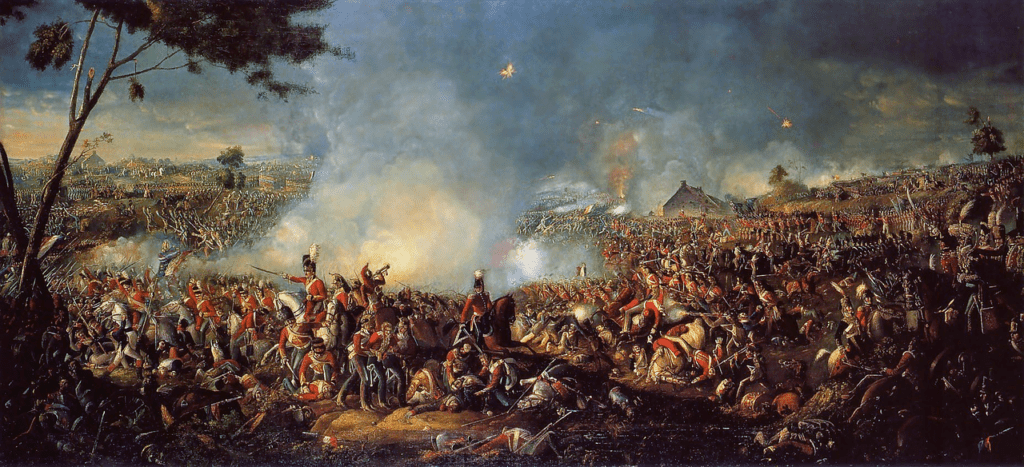
Battle of Waterloo - Bonaparte's miscalculation by Louis XVIII proved disastrous. The troops stationed outside of Paris deserted to Bonaparte on 19 March 1815, leaving the capital exposed to attack.
- However, Napoleon did not rule France for very long after the 18 June 1815 Battle of Waterloo, where he was decisively defeated by the armies of Field Marshal Blücher and Duke of Wellington.
- The agreement of the Allies was that Louis XVIII should be reinstated to the French monarchy.
Continuation of Louis XVIII’s reign
- Louis quickly returned to France following Napoleon's fall in order to achieve his second restoration. Instead, he advocated for continuity, reconciliation, and the pursuit of peace and prosperity.
- Louis XVIII's position in politics was voluntarily curtailed, and he delegated the majority of his responsibilities to his council. In the summer of 1815, he and his cabinet initiated a series of reforms.
- Anti-Napoleonic sentiment ran high in Southern France, and this was exemplified by the White Terror, which resulted in the removal of all key Napoleonic government leaders and the execution or assassination of others.
- Some of these officials were subjected to brutal crimes as a result of public fury. The marshal Guillaume Marie Anne Brune was brutally murdered, and his remains were thrown into the Rhône River.
- Louis XVIII fiercely backed the punishment of the marshals of the army who had aided Napoleon during the Hundred Days, despite officially condemning such criminal activities.
- In November 1815, Louis's government was compelled to sign a second Treaty of Paris, thus ending Napoleon's Hundred Days.
- To the fury of his brother, the ultra-royalist Count of Artois, Louis XVIII filled his cabinet with many centrists in an effort to please the population.
- Louis XVIII dreaded the day he would pass away because he believed that his brother and heir, Artois, would abandon the centrist administration for an ultra-royalist tyranny, which would not produce positive consequences.
- Louis, who was old and suffering from gout at the time, permitted the ultraroyalists to seize power.
Death
- The health of Louis XVIII began to deteriorate in the spring of 1824. He was suffering from obesity, gout, and dry and moist gangrene in his legs and spine.
- Louis XVIII passed away on 16 September 1824 at the age of 68, accompanied by members of the royal family and government leaders at the Louvre Palace. He was succeeded as Charles X by his youngest brother, the Count of Artois.

